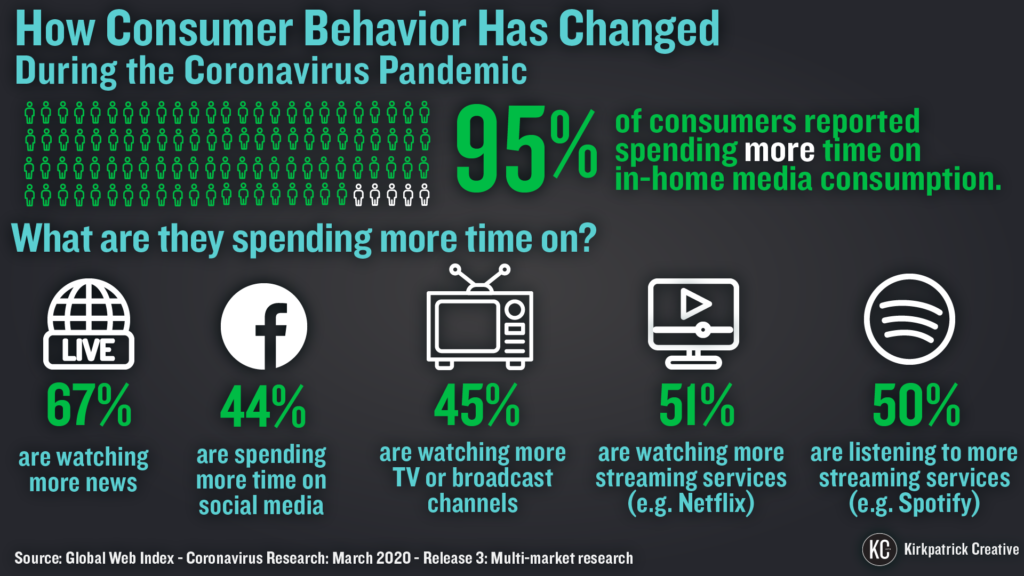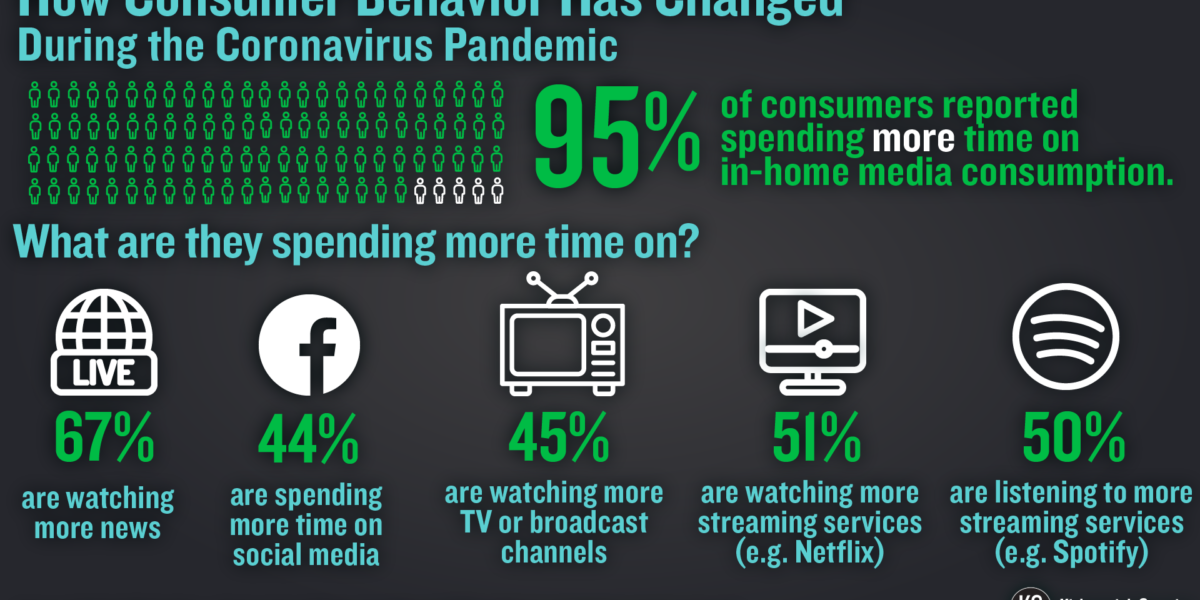What effects has coronavirus had on the advertising industry? Learn how the pandemic has changed the behaviors of consumers and marketers alike, as well as shifts we’re seeing in advertising content and strategy.
How Consumer Behavior Has Changed
Predictably, consumers are spending much more time online. They’re closely following the news, connecting with loved ones as much as they can, and looking for new ways to entertain themselves as they’re stuck at home.
In mid-March, GlobalWebIndex surveyed over 13,000 consumers across 13 countries about their online behaviors. They found that:
- 95% of consumers are spending more time on in-home media consumption
- 67% of consumers are spending more time watching news coverage; about half of these responded that they are spending “significantly more time” watching the news
- 44% of consumers are spending more time on social media
- 27% of consumers are spending “significantly more time” watching shows/films on streaming services

Online shopping habits are also changing. With everyone stuck at home, e-commerce is still going strong. “Since many work from home and stay indoors much more now than just recently, we will see a new type of online behaviour,” said Jonathan Olsson of Match2One, a programmatic advertising platform. “Consumers will be online at times which marketers may not be used to. Online activity and shopping could shift to mid-day, when activity in normal circumstances is low.”
The Winning & Losing Media of the Pandemic
Across the globe, spending on advertising has decreased. This isn’t too surprising: many businesses are paranoid that supply chain disruption will mean that they can’t fulfill their orders, so they don’t want to advertise products that they may not be able to sell. Cutting advertising budgets is also a money-saving measure as the economy stagnates.
This reduction in advertising means that media prices are dropping—for better or for worse, depending on how businesses prefer to reach their audiences.
Two major advertising media in particular have been impacted drastically by the pandemic:
- The value of out-of-home (OOH) advertising—things like billboards, public transportation ads, and other signage—has dropped dramatically as people remain in their homes.
- Event marketing has come to a complete standstill with mass cancellations of industry events like trade shows. Now, companies who rely on these events are flocking online to try to connect with their audience through video conferencing and other alternatives.
OOH and event marketing advertisers have nowhere to go but the internet. “Advertisers with a strong message for consumers may look to shift budgets from live events and OOH, so they can continue to access these now ‘displaced’ audiences,” Fran Cowan, the Vice President of Marketing at the UK Chapter of the International Advertising Association, told ExchangeWire.
Enter the advertising platform that’s benefitting the most from the pandemic: digital advertising.
There are several reasons why digital advertising is experiencing an upswing right now. Firstly, consumers are spending much more time online, so it makes sense that advertisers will follow. Secondly, as ad budgets get leaner, cost-effectiveness becomes paramount. Depending on the campaign, digital ads are some of the most efficient buys out there—and prices are dropping in the face of coronavirus.
“With many affected companies decreasing their marketing budgets, we will most likely see a sharp drop in CPM [cost per thousand] and CPC [cost per click] prices due to a decline in competition,” explained Olsson. “Marketers now have the opportunity to capture more eyeballs by advertising on these popular websites, at a lower cost than the pre-corona period.”
Finally, digital ads are agile: they can be updated much more quickly than traditional advertising like print ads or TV and radio spots. With the almost-daily changes in health and safety protocols we’ve seen since mid-March, that’s an essential confidence boost in your ad spend.
However, digital advertising is not necessarily an oasis in the desert of the advertising landscape. There’s a specific factor keeping it from being the absolute go-to during the coronavirus pandemic: supply chain disruption.
“Part of the reason advertisers, at least those that are directly involved in making products, are expected to reduce ad spending is to offset the financial impact of global supply chain issues caused by regional shutdowns over coronavirus,” said business writer Kali Hays. “Amazon is one platform that may see more immediate effects from such an advertising pullback…especially among its many smaller third-part sellers that already operate with smaller budgets.”
How Advertising Content Has Changed
Imagery Changes
We’re all obviously feeling more isolated than usual right now…but it may not be solely from social distancing or sheltering in place.
Pattern89 discovered that ads on social media are showing a lot fewer people than usual: “Even the models on Facebook and Instagram are practicing social distancing, as there are 24.7% fewer images and video ads that display models kissing, hugging, holding hands, shaking hands, or touching,” wrote marketing manager Bridget Johnson.
What’s replacing that human interaction? Solo people, mostly, and electronics (“now appearing in 39% of social ads,” according to Johnson). Plus, there’s been a huge jump in “clean” imagery: “Washing hands, washing faces and images and videos that display water or splashing/cleaning have sextupled on Instagram and Facebook ads,” the report states.
Messaging Changes
A few of our clients have expressed the desire to continue advertising, but to soften/sensitize the messages they’re sending (often going so far as to avoid referencing the virus by name). They are remaining conscious of what consumers want and expect to see during this time: it would certainly be odd to remain silent about the bizarre times we find ourselves in, but that doesn’t mean that every business needs to continuously post about COVID-19. People need a break!
So how should brands be communicating? “Locate your target audience and how their lifestyle has changed and map out how you should be targeting them,” suggested Olsson. “What is your target audience’s emotional context? What do they want to hear? How should you be communicating with them? Do not underestimate how the coronavirus has changed your customers and how it has affected their demands.”
So What Happens Now?
In the grand scheme of the pandemic, changes in the advertising industry aren’t that important. But companies still rely on it, whether they’re the small businesses being hit hardest, hospitals that have suddenly found themselves on the front lines of a war no one saw coming, or medical supply industries navigating the most demand they’ve seen in decades—if they’ve ever seen it at all.
Kirkpatrick Creative is a small business that is fortunate enough to still be functioning. We may not be able to do much in the way of comfort or cures, but what we can offer is advertising services to those in need of a little help. We’ve always been proud of our focus on cost-effective strategies, and saving money is more important than ever right now.
If your business or organization needs help with cost-effective digital, social, or livestreaming strategies, contact Kirkpatrick Creative today for advertising engineered to work hard for you—even during hard times.

